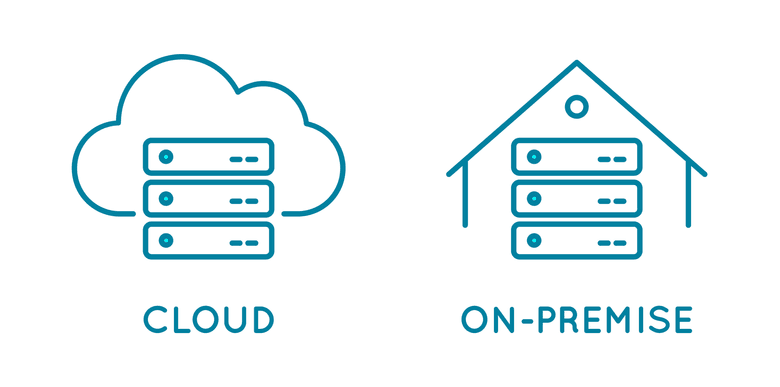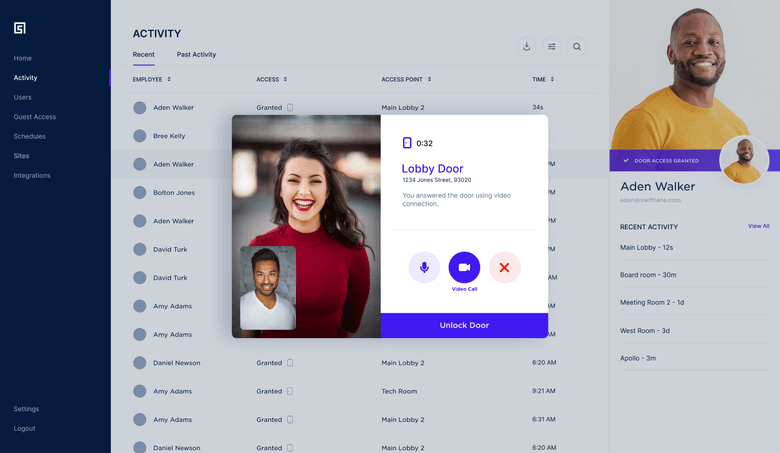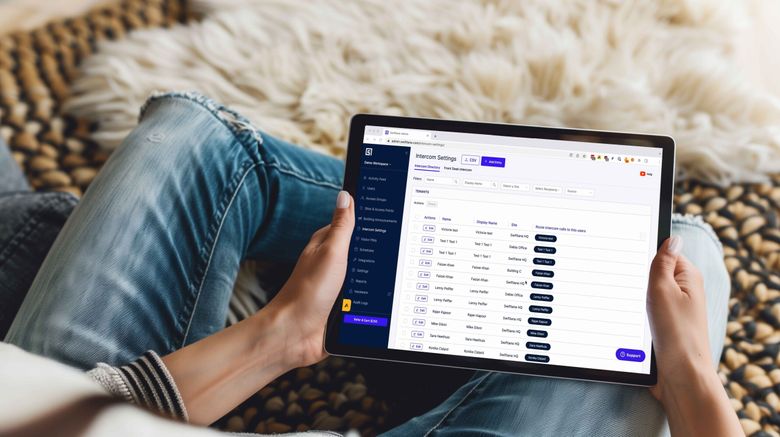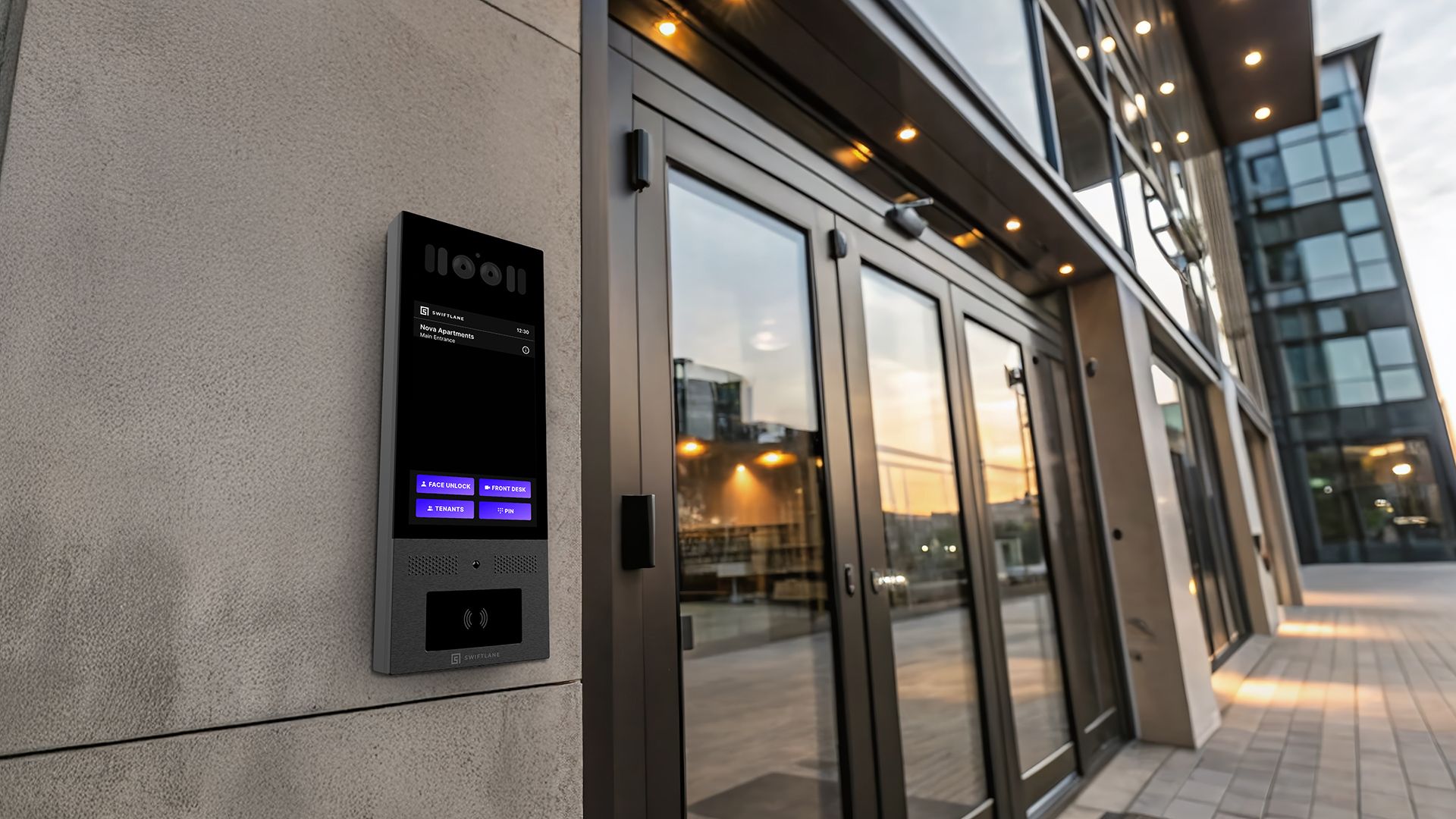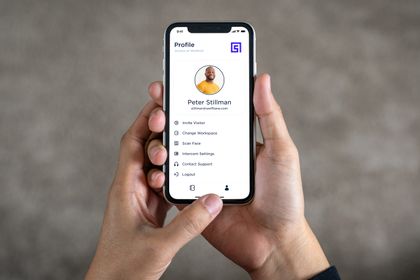If you’re in property management, chances are you’ve heard about cloud-based video intercom systems. These video intercoms connect over the Internet to a software platform and database in the cloud. These cloud services enable easy system management, provide a wireless connection between visitors and tenants, and use less hardware than other legacy access control systems.
In an age where technology continues to redefine convenience and security, cloud-based video intercom systems have emerged as a game-changer for residential, commercial, and industrial applications. These systems provide enhanced accessibility, streamlined communication, and improved safety, making them an essential tool for modern living and business operations.
This guide will walk you through the key features, benefits, and considerations when choosing a cloud-based video intercom system. We also review some of the top cloud-based video intercoms and cloud service platforms on the market.
Article Contents
- What Are Cloud-Based Video Intercom Systems?
- Benefits of Cloud-Based Video Intercoms
- Key Considerations When Choosing an Intercom System
- What Does a Cloud-Based Video Intercom Cost?
- Top Makers of Cloud-Based Video Intercoms and Cloud Platforms
- Consider Swiftlane for Your Cloud-Based Video Intercom
- Frequently Asked Questions About Cloud-based Video Intercoms
Popular Use Cases
- Residential Homes
- Monitor deliveries and visitors from anywhere, enhancing convenience and safety.
- Apartment Complexes
- Provide tenants with secure and independent access to shared entry points.
- Commercial Buildings
- Streamline visitor management and improve security protocols.
- Industrial Facilities
- Manage access for employees, contractors, and visitors efficiently.
What Are Cloud-Based Video Intercom Systems?
Cloud-based video intercom systems combine traditional intercom functionality with modern video and cloud technologies. Unlike traditional systems that rely on on-premises servers and wiring throughout the building, cloud-based solutions store and manage data in the cloud, and require a simple internet connection. This allows for remote access, real-time video streaming, and advanced features such as AI-powered analytics and seamless integration with other smart devices.
There is sometimes confusion and overlap between terms like wireless intercoms, IP intercoms, and cloud-based intercoms:
Wireless Intercoms: While many legacy intercom systems connect the main intercom to each tenant unit with wires, wireless intercoms use various radio frequency (RF) protocols to connect tenants and visitors. Most wireless intercoms use Internet Protocol (IP).
IP Intercoms: IP intercom devices speak to each other using the same communications protocol as the Internet, either over a local area network (LAN) such as ethernet (wired) or WiFi (wireless), or by connecting to the public Internet through a modem, WiFi, or cellular data network like 5G or LTE. IP Intercoms are the only kind that can access cloud services.
Cloud-Based Intercoms: Cloud-based systems are a subset of IP intercoms. They connect to a central server located “in the cloud” that is usually provided by a hardware manufacturer or a security services company. The online platform offers various features, some for ordinary tenants and others for building staff. Both wired and wireless intercoms can offer a cloud-based platform, but it is most prevalent among modern wireless IP intercom systems.
Benefits of Cloud-Based Video Intercoms
By connecting tenants, building management, and the main intercom through a centralized server on the cloud, these modern systems can offer a host of benefits and services not available to a standard intercom.
High-Quality Video
By definition, cloud-based video intercom systems offer a video link between tenants and visitors. With package theft on the rise, video has become the standard to confirm that visitors are who they claim to be. Two-way video also leaves a lasting impression in commercial spaces, showing customers, clients, and guests that the business cares about every visitor.
Remote Technical Support
Cloud-based systems can usually self-update the intercom’s software via the Internet connection and technical issues can be troubleshooted by the manufacturer or security service provider without sending a technician to the unit itself.
Streamlined Installation
Cloud-based systems connect the intercom and tenants without a lot of complicated wiring. Today, many intercoms only need to be plugged into a power supply and the door release mechanism. They find the internet via WiFi or cellular connections and work with minimal fuss and no stringing wires through conduits behind the walls. They’re a great solution for building retrofits and upgrades.
Property Management Integration
Building management can program the intercom using a user-friendly management platform located on the cloud without sending staff or a technician to the intercom to update the tenant directory, add/remove users, or check the data logs. This saves significantly on operating costs. If the management company has multiple buildings that use the same cloud-based intercoms, they can all be managed centrally over the platform and effectively put on “auto-pilot”.
Cloud Storage
Legacy systems often require each building to have a computer terminal on-site to host the intercom’s software and database. With cloud-based systems, there is much less hardware to own and maintain, cutting installation costs.
AI and Analytics
Many cloud-based intercoms integrate with other systems like building alarms and closed circuit television (CCTV) surveillance. By integrating all that data into the cloud, the cloud service provider can offer AI and analytics tools to get insights about traffic and identify potential criminal activity.
Mobile Access Control
Thanks to their internet connectivity, cloud-based intercoms can alert tenants to a visitor as a notification on their digital device. With most systems, the tenant can open an app on their phone, engage in 1-way or 2-way video chats, and remotely unlock the door with the push of a button.
Easy to Scale
Cloud-based systems are located on large central services, so they can expand to service huge numbers of tenants and multiple buildings all on the same account. With a cloud-based system, your access control is ready to grow with your property.
Key Considerations When Choosing an Intercom System
- Compatibility
- Ensure the system integrates seamlessly with existing devices and infrastructure. Either the product manufacturer or a third-party security services company can advise you about the compatibility of their products with existing in-building systems.
- Ease of Use
- Opt for a user-friendly interface and mobile app. Ask for a demonstration of the cloud-based platform and mobile app before you make a decision on this considerable investment.
- Security Features
- Look for features like encrypted data transmission and two-factor authentication to access the platform. Ideally, your chosen system maintains a video log of each entry request and traffic coming in and out of the building. This can be helpful for police reports and deterring repeat crime.
- Reliability
- Choose a system with a proven track record and robust customer support that is available 24/7.
- Budget
- Compare pricing plans, including upfront costs and subscription fees. Some intercom manufacturers charge a premium price to access the same features that are offered at a lower price by competitors. You may find intercoms priced between $2,000 and $3,000 with all the same bells and whistles of a device that costs $5,000.
What Does a Cloud-Based Video Intercom Cost?
When budgeting for modern internet-enabled video intercoms, keep in mind three cost areas: 1) the hardware, 2) the installation, and 3) the ongoing subscription fees.
Hardware: Modern video intercoms come in a range of designs, features, and price points. You’ll find models that start around $1,000, often for a small building that has a built-in camera but no built-in screen or directory. From there, models climb to over $6,000. Prices climb when the intercom includes features like a full-color touch screen, a durable weather and vandalism-proof housing, capabilities for 10,000+ users, and integration with other building systems like elevators, parking gates, CCTV, and alarms. However, it is possible to get all those features in models priced close to $2,000, like Swiftlane’s Swiftreader devices.
Installation: Although less cumbersome than wired intercoms, wireless cloud-based intercoms still usually require professional installation, especially to connect them to the door release mechanism. Your manufacturer will usually offer a list of authorized installation partners in your market. Budget $1,000 or more for installation, depending on the complexity of the system, but this will be far less than the cost of installing a wired intercom.
Subscription Fees: Intercom brands and security companies maintain their cloud-based platforms using subscription fees. Monthly costs often range from $3-$5 per month per tenant. While this is an ongoing operating expense, buildings can easily justify it through improved rents or building valuations, added security, reduced theft, and reduced maintenance expenses.
Top Makers of Cloud-Based Video Intercoms and Cloud Platforms
Several companies offer video intercom systems with cloud-based management platforms, providing enhanced security and convenience. Here are some notable cloud-based brands, most of which offer multiple intercom models that connect to the cloud:
| Company | Product Name | Key Features |
|---|---|---|
| AlphaTouch | AlphaTouch® Cloud-Based PoE Video Intercom System | -IP-based smart video intercom – Allows residents to see and speak to visitors via smartphone app – Features 7.0” touchscreen door entry stations – Cloud-hosted with visitor call logs and access control capabilities |
| Commend | Symphony Intercom Cloud | – Cloud-based intercom platform – Offers high availability with redundant servers and load balancing – Constant system updates without downtime – Integrates with other systems, including public mobile and fixed networks |
| Aiphone | IXGW-TGW Cloud Gateway | – Connects local intercoms with the IXG Mobile App – Provides property-wide control for enhanced security – IP-based emergency stations with embedded video intercom systems – Designed for various applications, including educational and commercial security |
| Swiftlane | Swiftlane Video Intercom System | – Combines video intercom, face recognition, and mobile access – Cloud-based system with two-way audio and video – Mobile app allows users to answer calls from anywhere – Offers touchless access control – Cloud platform integrates with the company’s Swiftreader and Swiftreader X intercoms. |
| 2N | 2N® IP Intercoms | – Offers cloud-based configuration and remote management – Integrates with video management systems – Provides maximum comfort and safety with sophisticated intercom products |
| Verkada | Verkada Intercom | – Enhances security with sharp video and clear audio – Built-in access reader – Cloud-managed call routing – Scalable across multiple devices |
These companies provide a range of cloud-based video intercom solutions suitable for various applications, from residential to commercial settings.
Consider Swiftlane for Your Cloud-Based Video Intercom
Swiftlane’s intercoms feature our own cloud-based platform. Through our platform, our technicians can troubleshoot and help maintain our hardware 24/7. Our stand-out feature is facial recognition access control, which lets each tenant open the door by looking at the intercom camera. Our Swiftreader X features:
- Full-color two-way video.
- Large 8” full-color touchscreen with built-in directory.
- High ratings against extreme weather and vandalism (IP65 and IK10)
- Access using key fobs, PIN and QR codes, mobile devices, and facial recognition
- Integration with elevators, pedestrian and vehicle gates, security, and surveillance systems.
Get in touch with us for a demonstration of our cloud platform and tenant app.
Frequently Asked Questions About Cloud-based Video Intercoms
How does a cloud-based video intercom system work?
The system works by capturing video and audio through a camera and microphone installed at an entry point intercom. The data is then sent to the cloud where it is processed, stored, and transmitted to tenants. Users can view live video feeds and communicate with visitors through their mobile phones, tablets, or computers via a dedicated app or web portal.
Is the video feed secure?
Yes, most cloud-based video intercom systems use encryption protocols (such as HTTPS, TLS, or SSL) to ensure that video and audio data are transmitted securely. Additionally, two-factor authentication and other security measures are often implemented to protect your privacy.
Can I store the video footage?
Yes, cloud-based video intercom systems often offer cloud storage options where you can store video footage for a set period of time. The storage duration and capacity can vary depending on the service provider and the subscription plan.
Do I need a constant internet connection for the system to work?
Yes, a stable internet connection is essential for the system to function properly. Both the intercom devices and the user devices (such as smartphones or computers) require an internet connection to communicate with the cloud. Many intercoms include a backup, so if WiFi goes down, a cellular data connection may take over. During a blackout or total internet outage, tenants can often resort to using ordinary keys.
Can I integrate the system with other smart home devices?
Yes, many cloud-based video intercom systems can be integrated with other smart home or office devices such as smart locks, security cameras, or alarm systems. This creates a more unified and efficient security ecosystem.
How do I manage users and access control?
User management is typically handled through the cloud platform. You can assign different levels of access to users, such as admin privileges or restricted access to certain areas. This allows you to control who can view the video feed and interact with the intercom.
Can multiple users access the system simultaneously?
Yes, cloud-based systems often support multiple users accessing the system at the same time. You can allow various users (family members, staff, security personnel) to view the video feed or interact with visitors through their devices, as long as they have the proper permissions.
Need More Info?
Still have questions about cloud based access control systems? Contact a Swiftlane expert to navigate your options and the best solution.


